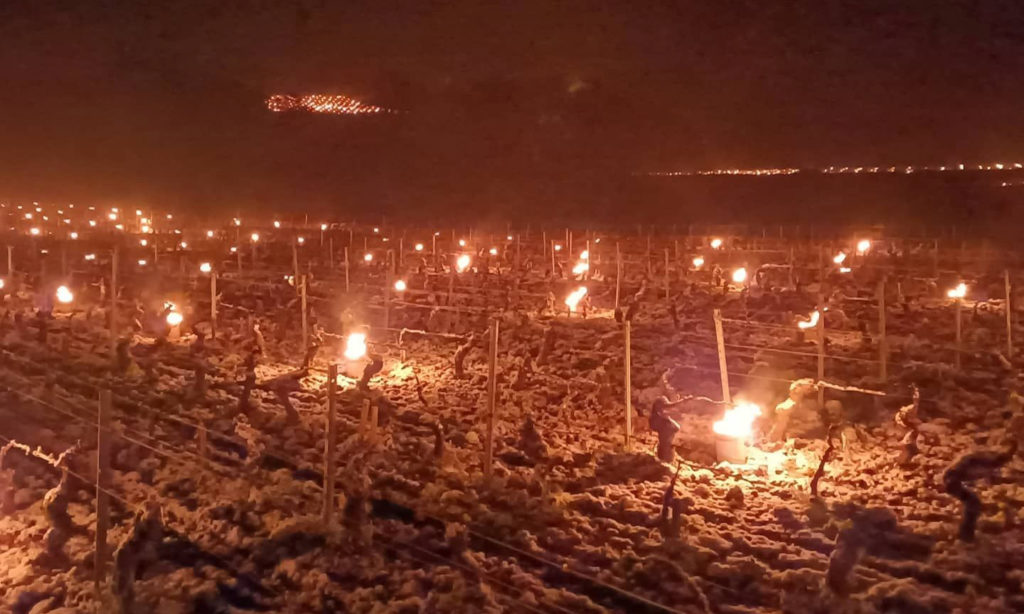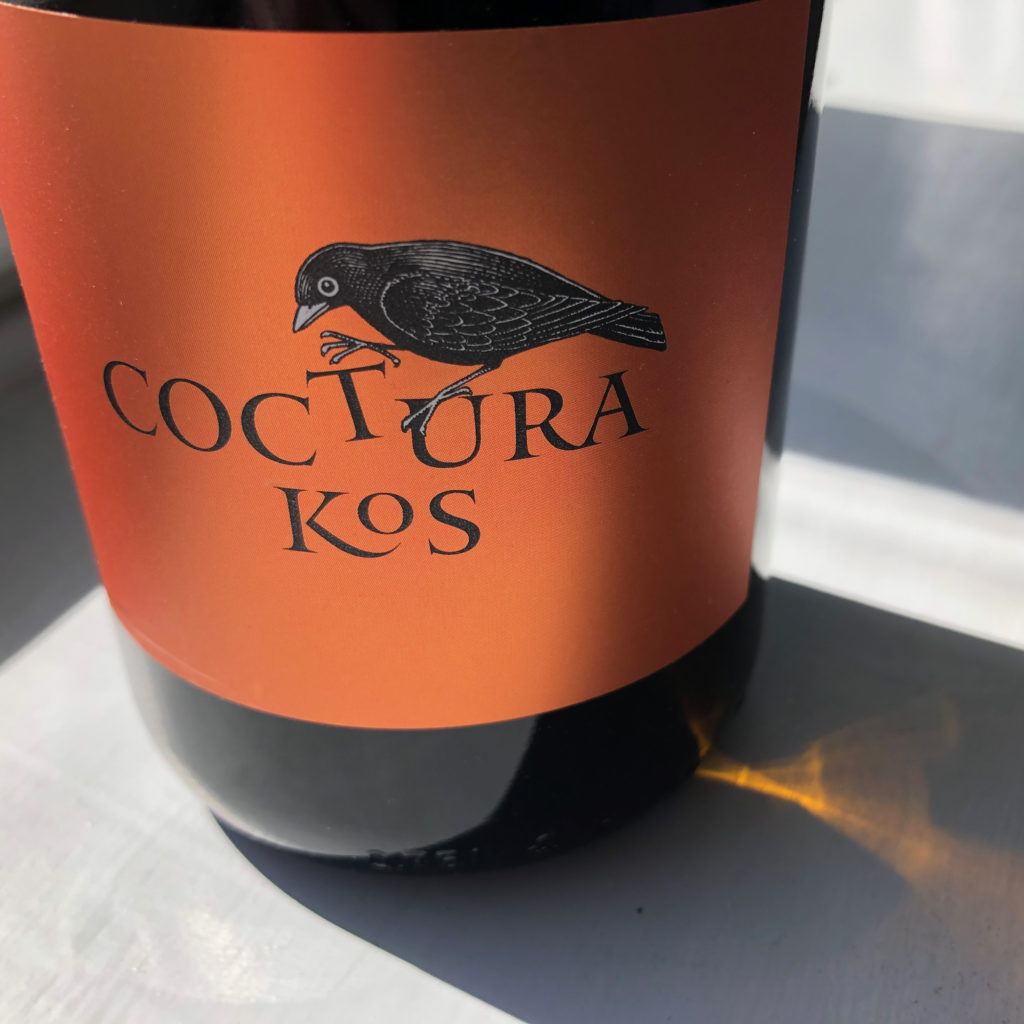This is the fourth in a series of 12 monthly articles following eight Croatian wineries through their year. We introduced this month’s group of wine makers in the February article.
At the end of the first week of April, the wine-loving world learned that Burgundy had been devastated by frost. The Burgundian practice of lighting “candles” in the vineyards may be beautiful, but the need for it is deadly serious. Even after warming the vineyards in this way, Burgundian growers lost an estimated 30 percent of their crop for this year due to frozen buds and young shoots. The candles are actually metal buckets filled with paraffin or solid biofuel, with a cardboard wick. Each will burn for six to eight hours, depending on the size. The catch? You may need 300 to 400 buckets per hectare of vineyard!
Most of northern France, locations in Italy, and elsewhere in cool-climate Europe were affected by this frost event. And Croatia did not escape unharmed.

Vina Kos
It is three days after the disaster in Burgundy, and Karlo Kos has his own version of events to deal with. “The temperature was high the first week in April,” he says, which caused bud break to begin. “But now we had frost. The temperature was minus 7 degrees [Celsius] and we expect a lot of damage in the vineyard. We think this damage may be 30 percent of our future grapes.”
It’s difficult to be sure of the extent of damage at this early stage. “We have some shoots that are 1 centimeter and those shoots are black. They are dead. But the buds that are tiny, you can’t see. It looks normal, but usually minus 3 degrees is bad for those buds and we had minus 7. We can wait a month when the shoots are bigger, and then we can see how many flowers we have left.”
The frost affects earlier-budding varieties such as Pinor Noir and Kerner most severely. The later buds of varieties like Riesling and Kraljevina should still be safe.
In Croatia there is very little a grower can do to protect against frost. Speaking of Burgundy, Kos says, “They have many more hectares in the vineyards so it’s maybe easier to defend from frost. We have smaller vineyards and it’s impossible to do anything. And the cost is too high . . . for our production.”
Not to dwell on the loss, Kos adds, “Okay, some buds are destroyed, but a lot of buds will grow and we will do everything like last year. We will have smaller production, but we’ll do everything like usual.”

Spraying is the first task in the vineyards now that bud break is under way. Kos will use copper, an organic treatment, against vine mites and other early pests when the shoots reach 7 to 15 centimeters in length. “Maybe in the southern region, in Dalmatia, because of the weather they don’t have so much disease. But here we have a lot of rain and we have to spray earlier and maybe every two weeks from vegetation to harvest.”
In the winery, Kos has just bottled the 2020 Kraljevina and rosé. He has also moved their orange wine, called Coctura, to the next stage of production. These Riesling grapes spend months fermenting with their skins, drawing out flavor, tannins, and an amber-orange hue. “From harvest until now we had it in oak barrels, and now we pumped it and pressed the [skins]. Now that wine is in a [stainless steel] tank and we have to wait maybe six months for it to settle because we don’t filter that wine . . . and then in December we will bottle.” The wine will not be released for sale until it has spent 18 months or so aging in the bottles.
Galić
Farther east, in Kutjevo, there was also frost. “It was two days in a row, early in the morning,” says Slaven Jeličić. “It was minus 3.5 to minus 6.2. I hope with the vineyards it’s maybe 5 to 10 percent damage.” In Kutjevo, Chardonnay and Pinot Noir are the early varieties that may be affected, even now before bud break has begun.
For Galić it wasn’t grapes but their 9 hectares of blueberries that were in the most danger, because the blueberry plants develop ahead of the grapes. About ten people spent two whole nights in the blueberries, trying to keep the plants warm. “We had 23 fires around the blueberries and we saved the blueberries!” says Jeličić. These weren’t bucket fires but bundles of wet, slightly moldy cornstalks and wheat dropped off by one local farmer. “This was perfect for us,” says Jeličić, because the material produced good smoke that spread warmer air through the berry bushes. The result was that it was minus 6 degrees in the area around the blueberries but 0 to 1 degree inside the plot because of the fires. The same principles work for warming grapevines.
Until about three years ago they didn’t have trouble with frost in this area of Slavonia, Jeličić explains. Only now, frost seems to be a trend. In the next year, Galić will make sure it has a system set up to warm the vineyards like they do in Burgundy. They will also have insurance for all the vineyards against frost and hail.

Now that vegetation is beginning, on the vine and on the ground, each grower needs to maintain not only the vines but the spaces between them. Options for this space range from bare earth to a veritable jungle of grasses, and the Galić team comes down firmly on the side of grass. “Our theory is without grass you have nothing, just like the moon surface,” Jeličić says. “When you don’t use glyphosate and all the chemicals we don’t use anymore, you immediately get all kinds of grasses and flowers.” The philosophy at Galić is to foster a balanced ecosystem in the vineyards, which helps cut down on the number of treatments they use.
In the winery, there is always bottling to be done. Among the next on the bottling line will be four wines from the vineyards Galić owns in northern Dalmatia, near the Testament vineyards. The grapes for these wines—Babić, Plavac Mali, Tribidrag and Pošip—are harvested and then shipped in refrigerated trucks to Kutjevo for winemaking. Soon Galić will build a winery and tasting room in the Dalmatian vineyards. For Slaven Jeličić, who is from Split, this is a welcome return to home ground.
Benvenuti
The frost event in central and eastern Croatia was a snow event in Istria. “It was a big snow for April,” says Nikola Benvenuti. “I think there will be some damage, but not big damage. Somebody will lose maybe 5, 10 percent of something.” Any losses will be to earlier varieties, which are Chardonnay, Pinot Noir or Sauvignon, but these are not the primary grapes in Istria. Malvasia and Teran start bud break a little later, so they’re safe for now.
By the end of April in Istria, there will be a carpet of fresh green colors between the vines. “We started having green between the rows,” Benvenuti says. “We now work only below the vine. It’s around a half meter worked, and the rest we leave green.”

For Benvenuti, leaving plants between the vines serves two main purposes. “Because we are in a hilly place, we have big problems with water on our terraces,” he says. When there is a lot of rain at once, the water washes the soil away. “When you have the grass this doesn’t happen.”
Turning the earth between the vine trunks and keeping that zone free of grass targets any rainwater directly beneath the vines—it’s a safe bet for dry summers. “And you can always calculate . . . if you see that the year is too dry you can always go in and work [the soil] or cut [the grass]. But if you see a lot of rain you just leave it.”
“The other thing is competition. Competition between grass and vines,” Benvenuti explains. The competition is for nutrients in the soil. “Our philosophy is to produce less, and more quality. We don’t need too many grapes on the vine. The grass is very good in the middle because the quantity of grapes is always less when you have competition. If you . . . have a big push and too many grapes—then the quality is so-so.” Grapevines famously love poor soil, so having grass between the rows helps give them what they want.
“It’s also nice to see it,” Benvenuti says with a smile.
When the vine shoots are about 10 centimeters long, later this month, the team at Benvenuti will start shoot thinning. “There are sometimes two or three shoots from one bud. If we have too much on one vine, we remove some to have more air [circulating in the leaves] from the beginning,” says Benvenuti. There are also shoots growing up from the trunk that need to be removed two or three times a year. Otherwise these would take water and nutrients that should instead go higher up, to the fruit zone.
Testament
It’s almost a different world in northern Dalmatia. The same weather front that brought deadly frosts in the eastern wine regions and Istria was simply an unseasonal snow shower here. There was no vine damage. At Testament, green leaves are unfolding on most of the vines now. The just-planted vines of Lasina may be farthest along. “It’s not the earliest [variety],” says Juraj Sladić, “but it’s freshly planted, so you have a very shallow layer of soil, and the top part is warmer. The roots are close to the surface and that has an effect on bud break.” Pošip is generally first to break, and those vines now have a combination of leaves and green, fuzzy buds.

There is no plan to spray yet. “Never this early,” says Sladić. “We have a nice position which allows us to have organic production. If I spray, I spray maybe two times in total. The whole season.”
Instead they are plowing between the rows, and removing weeds by hand from beneath the plants. A few weeds do find their way through the stones. By plowing, Sladić says, “we want to remove those and we want to preserve moisture that we collected during the winter.”
The vineyard team will also start fertilizing, using organic manure pellets. “It’s produced in a factory. Dried manure, pressed into pellets.—Yes, it smells!” Sladić laughs. “This [type] is better because you are not applying any moisture or hay to the ground, only pure fertilizer. It’s dry, so you don’t apply weed seed, bad insects . . .”
Early in May the team will start to remove the excess buds from the vine trunks and canes. “We start when they are 10 centimeters [long],” Sladić explains. “It’s a huge property, so we start with Posip and Tribidrag and when we finish the last of the Babić, then it’s already, I don’t know, a half meter or even longer.”
In the winery, Sladić has been preparing shipments to foreign markets, launching one of Croatia’s first wine clubs, and getting ready to release Testament’s new premium line of Tribidrag, Plavac Mali, prošek and a macerated Pošip called Zenit. Vineyard work and winemaking may be glamorous jobs, but sales and marketing will put that wine in a glass!
[Title photo: Young Lasina vines were among the first to see bud break at Testament Winery in Dalmatia. Staff/CCM]

